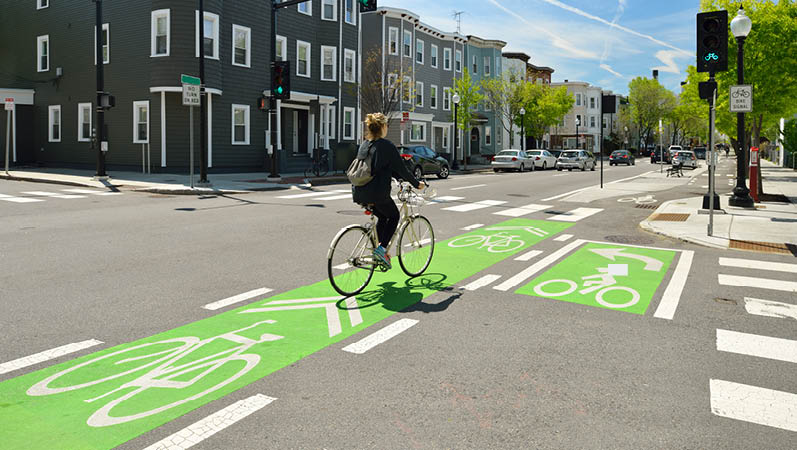Steel yourselves for spring and summer construction delays. And in this case, it affects bikes and pedestrians, too.
In case you missed it, Denver voters unanimously approved measure 2A last November to fund transportation projects around the city. The passage of this ballot initiative, which raised the local sales tax by .25 percent, ensures the construction of 33 new miles of sidewalks and nearly 50 miles of protected bike lanes and neighborhood bikeways throughout the community.
More than $70 million is now designated to eliminate missing segments of the sidewalk and bike networks, and $115 million overall is earmarked for bike-pedestrian projects across the city. This comes at a time when Denver’s population has exploded and residents are seeking alternative modes of transportation. While cars continue to clog the roadways, Denver residents have responded by advocating that more money be spent on new bike lanes and sidewalk repair/extensions, and ensuring access to dockless bikes and scooters around town.
In a recent interview with Westword, Denver mayor Michael Hancock addressed the transportation issues the city is facing.
“Equity must be a value that applies to everything we do as a city, including mobility,” he said “It’s time our streets learn to share. To keep Denver accessible, affordable and equitable, residents must be able to get around the city easier with more reasonable transportation options. I launched a Mobility Action Plan that is investing $2 billion to address Denver’s congestion and accelerate projects, policies and programs to move more people more efficiently and more safely.
“Denver’s people deserve safe, reliable options such as mass transit, bikes, scooters and pedestrian paths. My Mobility Action Plan addresses the ways in which we can embrace these types of transit options and make them easier to access from all parts of the city. To help encourage the use of alternative transportation modes, we are working on such projects as increasing priority routes on main corridors — including a new Colfax Rapid Transit express route. We are also adding miles of protected bike lanes and paths, and we are improving signs, signals, striping and paving throughout the city to make it easier for pedestrians and wheelchair users to get around…”
Denver Infrastructure Wasn’t Meeting Demand
Prior to the passage of 2A, Denver was spending $5 million annually on pedestrian and bike corridors according to the League of American Bicyclists Benchmarking Report (2016 figures). That figure was 6 times less than that of Seattle, a city comparable in size to Denver, and pedestrians fatalities in Denver involving a car are double that of Seattle.
Denver’s population growth over the last eight years was a driving force behind the initiative and its subsequent passage. With more people living and working in the city comes significant challenges on how to balance car traffic, and the rights of pedestrians and cyclists on the roads.
According to World Population Review, the Mile High City had 619,356 residents in 2011; by 2017, it was 704,6221. That’s almost 100,000 new residents in just six years.
Cyclists, Pedestrians Pay Deadly Price for Dangerous Roads
It goes without saying, that increased density of people puts a strain on transportation systems, especially the roadways. Amid the enormous population increases in the city, congested roadways have been unable to meet the demands of people who want to use alternative modes of transportation when getting to work, school, appointments and amenities/entertainment venues. And, unfortunately, deadly interactions occur. According to the Denver Streets Partnership, 59 people died in 2018 as a result of pedestrian-car accidents, the 2nd highest number since 2005.
In a recent interview with Westword, Piep van Heuven, policy director of Bicycle Colorado, said, “Denver has a public health epidemic, right now, with speeding and irresponsible driving. We can tell these stories on every major arterial in and around Denver.” She cited Broadway, Federal Blvd., Colfax Ave. and Hampden Ave. among the city’s most dangerous roads.
Making Denver Streets Friendly for All Users
Denver Streets Partnership has been a driving force in improving the infrastructure in the Mile High City for pedestrians and cyclists. The organization is a coalition of community organizations advocating for making Denver streets “people friendly” for both pedestrians and cyclists. The steering committee is comprised of nine organizations: Walk Denver, Bike Denver, Bicycle Colorado, CoPIRG, Colorado Cross-Disability Coalition, Groundwork Denver, American Heart Association, Vision Zero and All in Denver.
Denver Streets Partnership states as their mission “to improve active transportation and transit infrastructure, accessibility, and use to support healthy, inclusive, connected, and sustainable communities. We coordinate advocacy and community engagement efforts in four main areas: transportation funding, policy development, vision zero and corridor transformation.”
At the heart of the matter, according to DSP, is the population of Denver that can’t and/or doesn’t want to drive. As parking lots are being turned into buildings at an increasing rate, the price of parking has skyrocketed and increasingly, the city is trying to discourage the use of cars downtown. Now, with numerous light rail stations, planned improvement of bus routes and bike lanes, dockless electric scooters and shared ride companies like Lyft and Uber, more and more people are electing to use alternative modes of transportation to get to Denver.
New, Improved Sidewalks Will Make Walking Easier
According to the city of Denver, there are 355 miles of missing sidewalks. Beginning in 2018, Denver’s Sidewalk Gap Program began to fill in these sidewalk gaps and create a complete sidewalk network, enabling pedestrians to safely access their destinations. This program will attempt to deliver the pedestrian-related goals that the community requested including the following:
- Accessibility
- Connectivity
- Access to Destinations
- Equity
- Health
- Safety
The gap program is funded primarily by GO Bond dollars which was approved by voters in November 2017. The bond included $47.7 million to build sidewalks where they are currently missings, with $17 million specifically earmarked to close gaps in the Globeville, Elyria and Swansea neighborhoods.
Furthermore, according the city of Denver, the Denver’s Neighborhood Sidewalk Repair Program (NSRP) is addressing sidewalks, citywide, that are damaged, uneven, or sloping excessively. Denver Public Works has identified 11 sidewalk regions by grouping neighborhoods into roughly comparable areas, and will begin addressing one region at a time, using criteria based on community feedback gathered in the Denver Moves: Pedestrians & Trails plan. Per city ordinance, Denver property owners are responsible for the repair and maintenance of sidewalks adjacent to their properties. To help with the repairs, the City will offer extended repayment assistance and discounts for property owners who qualify. The City is also authorizing less expensive repair methods not previously allowed, such as grinding and crack filling.
New Protected Bike Lanes in Downtown Denver
There are now many protected bike lanes on busy downtown streets includes 14th, 15th, Arapahoe and Lawrence Streets. There are also a number of on-street lanes and routes that link to the off-street trails of 20th Street, South Platte River and Cherry Creek Trail.
Currently, Denver has built 100 miles of multi-use trails, 130 miles of bike lanes, 39 miles of shared lane roads and almost 400 miles of signed bike routes. The city will add 125 miles of bike lanes in the next five years.
According to Mayor Hancock, Denver Public Works will boost delivery of the bikes lanes over the next two to three years and will leverage a new approach of creating better neighborhood bike networks that focus on connectivity for the residents and businesses in the area.
Check out some the new bike lanes and projects for 2019.




